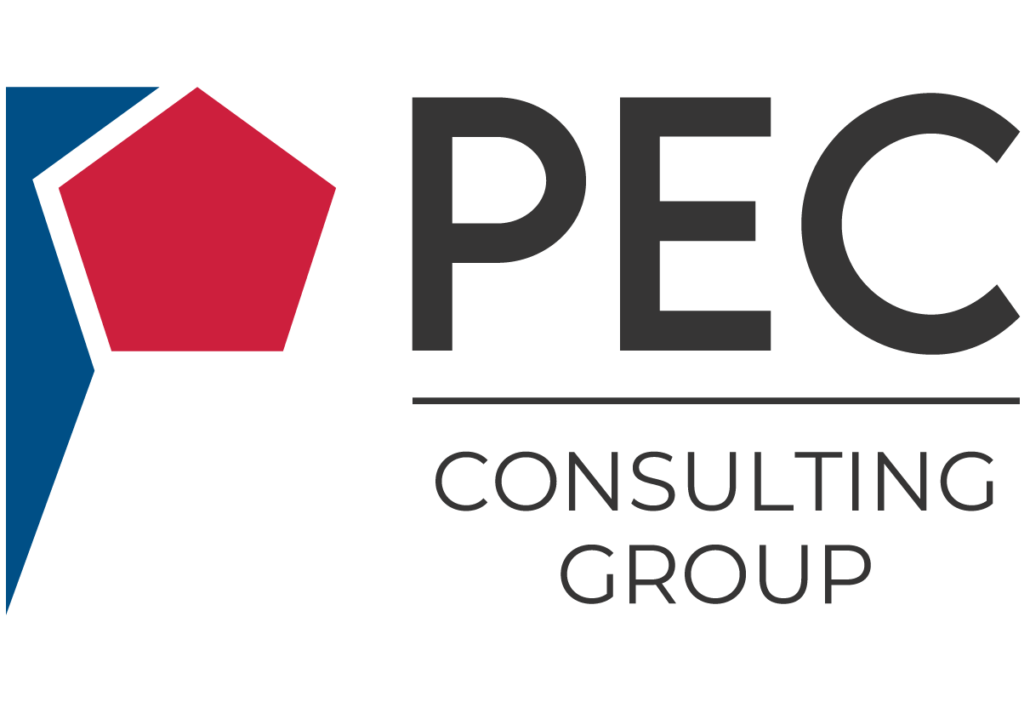Environmental and Qualitative Benefits of Supplementary Cementitious Materials
By Bruno G. Diaz and Francisco M. Benavides
1. Introduction
Concrete is the most widely used construction material in the world. Approximately 10 billion tons of concrete are produced each year. On average, 15% by weight of concrete is cement, and each metric ton of cement produced generates 900 kg of CO2, making cement production account for 9% of CO2 global emissions. However, a reduction in the amount of clinker-to-cement ratio using blended cements, a combination of Portland cement and supplementary cementitious materials (SCMs), can reduce greenhouse gas emissions. This paper discusses the various SCMs available for use in concrete production and their benefits to the environment and concrete properties.
The construction industry is a large contributor of CO2 emissions globally, in part due to cement’s high carbon footprint, accounting for 9% of CO2 gases, along with sulfur dioxide and nitrogen oxides. According to the U.S. Environmental Protection Agency (2020), the cement sector is the third-largest industrial cause of pollution, contributing 2.5% more carbon dioxide than aviation fuel and 12% more than the agricultural business (Rodgers, 2018). These high quantities of carbon emissions are generated for the most part in clinker production, the major ingredient of Portland cement.
For instance, Figure 1 below illustrates emissions along the cement industry supply chain, indicating that 90% comes from clinker production, distributed in 50% process emissions and 40% thermal emissions, the results from heating the materials at high temperatures in the kiln. The remaining 10% of emissions account for quarrying, preparation of materials, cooling, grinding, mixing, and transportation.
Figure 1. Emissions Along the Cement Supply Chain
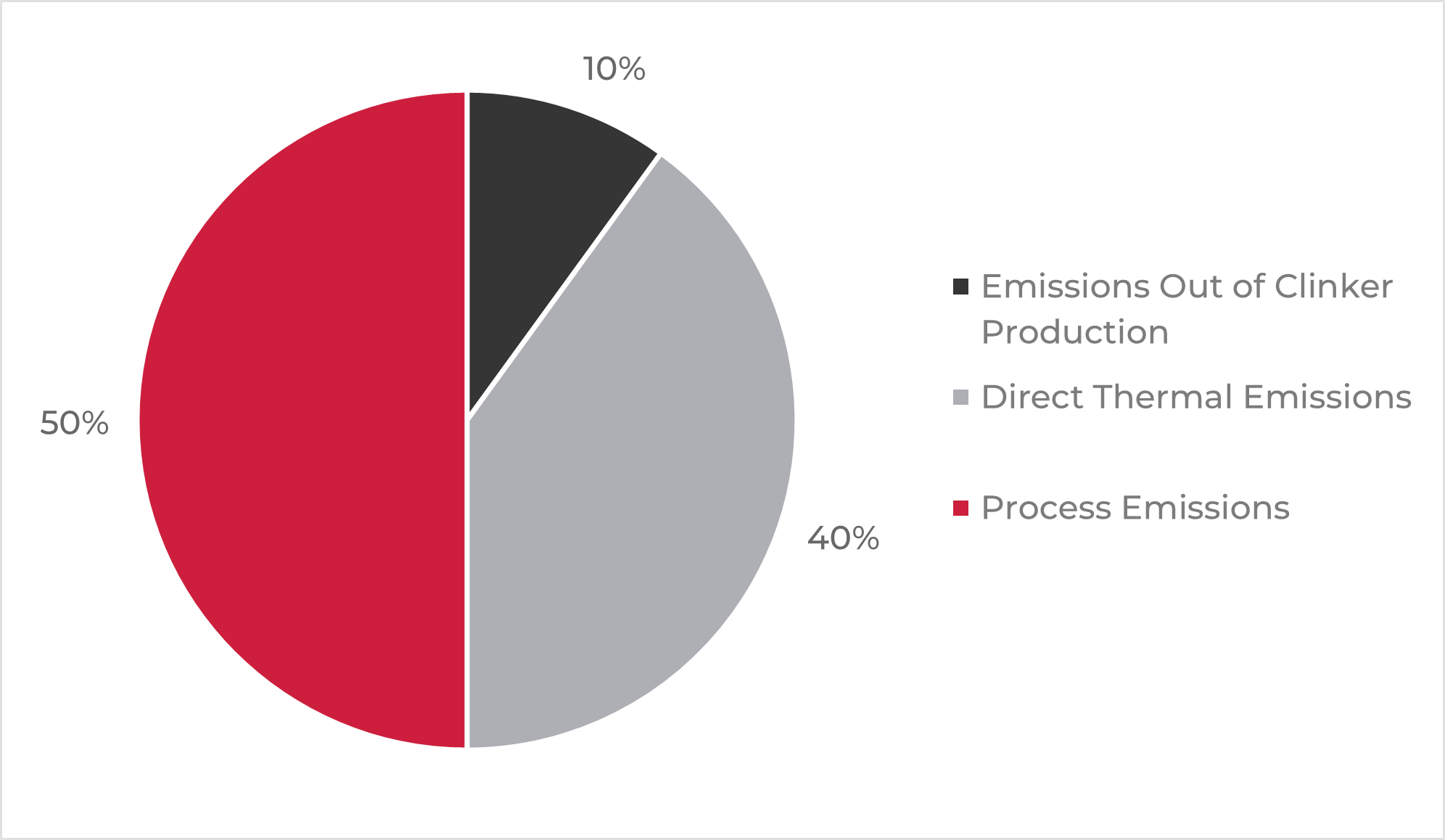
Note. Adapted from Preston, F., & Lehne, J. (2018). Making Concrete Change: Innovation in Low-carbon Cement and Concrete. Chatham House.
CO2 emissions from global cement manufacturing have increased dramatically in the last 30 years. Figure 2 below shows China as having the highest CO2 emissions; approximately 827 million metric tons, as China manufactures over 50% of the global production of cement, generating twenty times more emissions than the United States in 2019.
The contamination generated by cement production can be reduced by many means, from using alternative non-fossil fuels to improving production efficiency. Addressing the reduction of clinker-to-cement ratio by using supplementary cementitious materials (SCMs) can be the most expeditious and economical method in the short term.
Figure 2. Global Cement Manufacturing CO2 Emissions 1990-2019, by Country
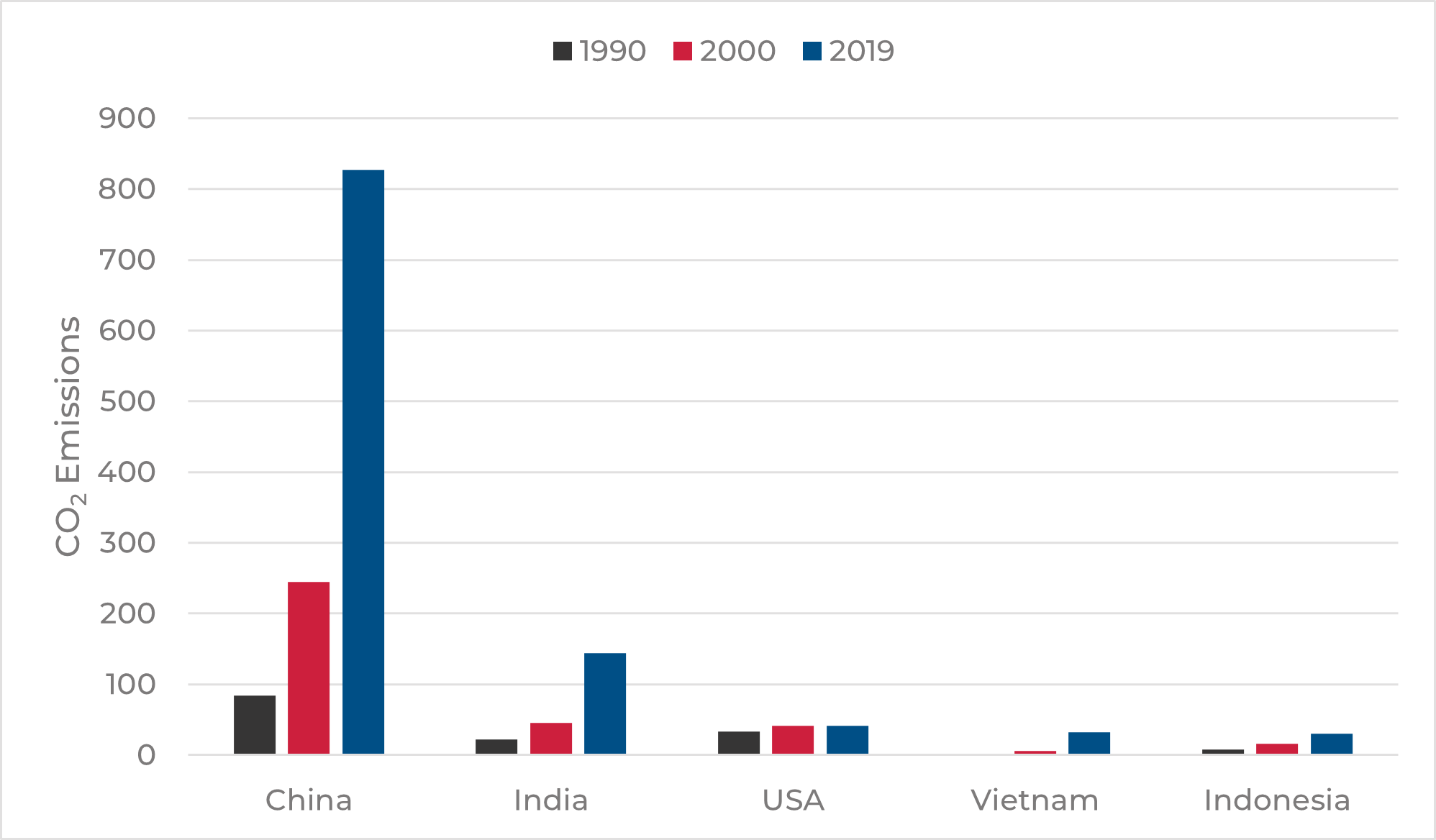
Note. Units in million metric tons. Adapted from Statista. (2021, January 14). Global cement manufacturing CO2 emissions 1990–2019, by country. https://www.statista.com/statistics/1091672/carbon-dioxide-emissions-global-cement-manufacturing/
2. Supplementary Cementitious Materials
SCMs are a cementitious addition to concrete partially substituting Portland cement. Some materials used as SCMs are blast-furnace slag, fly ash, silica fume, and natural pozzolans (Kosmatka and Wilson, 2016). There are benefits to the use of SCMs, like improving durability, diminishing alkali-silica reaction, and enhancing other concrete properties for infrastructure applications.
SCMs originate in nature as pozzolanic minerals or are produced industrially, more commonly as by-products of industrial processes. The SCMs that are more readily available are coal combustion residuals, GGBFS, silica fume, and natural pozzolans (Nicoara et al., 2020).
2.1. Coal Combustion Residuals
A by-product resulting from coal combustion in power plants is fly ash, small particles chemically composed of SiO2, CaO, Fe2O3, and Al2O3 (Sun et al., 2019). Fly ash is an excellent component for blended cements or concrete due to its potential for pozzolanic activity, but fly ash is usually limited to 15-25% of replacement levels for cement in concrete (Sun et al., 2019).
High-volume fly ash (HVFA) concrete contains 40% fly ash by mass of total SCMs, developing high concrete strength, high resistance to alkali-silica reaction when using cement replacement by 40-70% fly ash (Sun et al., 2019). It is a great help for reducing emissions and overcoming crucial problems concentrated on sustainable construction (Nicoara et al., 2020).
Even though the use of fly ash results in many benefits like improving concrete performance, workability, strength, and durability, the wide variation in the fineness, the chemical composition, and the mineralogy of the fly ash when developing an ideal composition of concrete with HVFA remains quite complex (Coppola et al., 2018).
2.2. Ground Granulated Blast-Furnace Slag (GGBFS)
This material is a by-product of the manufacture of iron in the blast furnace. GGBFS is appropriate for ready-mix concrete, site-batched concrete, and precast product manufacturing (Samad et al., 2017).
GGBFS has resulted in high strength and performance concrete when used as cement replacement, having more compressive and flexural strength than regular concrete when replacing cement by 40% (Samad et al., 2017). However, due to considerable variations of physical properties of GGBFS from the different sources and regions, the effect that it has on the concrete also changes substantially (Samad et al., 2017).
2.3. Silica Fume
This material was part of the end-of-life products from industrial processes, but now it is used for “ultra-high performance concrete” (Nicoara et al., 2020). Silica fume is a fine powder formed by very small particles of SiO2, 100 times smaller than cement particles, providing relatively high pozzolanic activity and creating a “net effect” resulting in better adhesion among the paste, the aggregate, and the cement (Nicoara et al., 2020)
As noted by Nicoara et al. (2020), the use of silica fume as a supplementary cementitious material positively affects the concrete, increasing mechanical properties due to efficient filling, improving the concrete durability in the long term, and concrete strength in both the long and short terms; in addition, silica fume improves concrete density (reducing porosity), and reduces bleeding and segregation, resulting in superior performance concrete.
Furthermore, silica fume improves the mechanical strength of concrete and other physical and chemical properties like decreasing permeability and increasing protection against corrosion for reinforcing steel bars, while lowering emissions to the environment (Nicoara et al., 2020).
2.4. Raw and Calcined Pozzolans
Natural pozzolans (volcanic ash) are siliceous materials with cementitious value that can be used as a cement substitute in concrete or to make pozzolanic cements, found in natural mineral and volcanic deposits (Hanson, 2017). Common synthetic pozzolans are calcined clay, shale, and metakaolin; other less common are rice husk ash (Hanson, 2017).
Natural pozzolans are packed together over time into vast deposits of tuffs and other rhyolitic minerals (Natural Pozzolan Association, 2021); volcanic ash possessing pozzolanic behavior without the calcination process are denoted as true natural pozzolans (Hanson, 2017).
Calcined pozzolans are materials derived from clays and shales after applying considerable heat to be transformed into pozzolans. After the calcination process, the material is ground into a fine powder to be used as an SCM (Hanson, 2017).
3. Environmental Benefits of Using SCMs
The use of materials like fly ash and ground granulated blast furnace slag (GGBFS) as SCMs instead of being placed in landfills results in environmental benefits due to less demand of fuel and limestone (Hossain et al., 2018). Additional environmental benefits are derived from these materials because they are by-products from other industries. Having the required pozzolanic and cementitious properties makes them ideal for reducing the clinker demand while keeping “similar compressive strength at certain replacement levels” (Miller, 2018).
Climate Earth (n.d.) compared a regular mix of cement against the use of SCMs in their report “Green Concrete Design Report,” as shown in Figure 3. This figure contrasts the impact for 4,000 PSI concrete mixes using standard Portland cement mix (0% of SCM) against using 40% of SCM substitution, indicating an average production of 398 Kg of CO2 equivalent per cubic meter of concrete versus 325 Kg of CO2 equivalent per cubic meter, respectively. As a result, the report shows that a 40% SCM substitution decreases CO2 released to the environment by 20%.
Figure 3. Range of Impacts per 4000 PSI Mixes, with 0% SCM Against 40% SCM
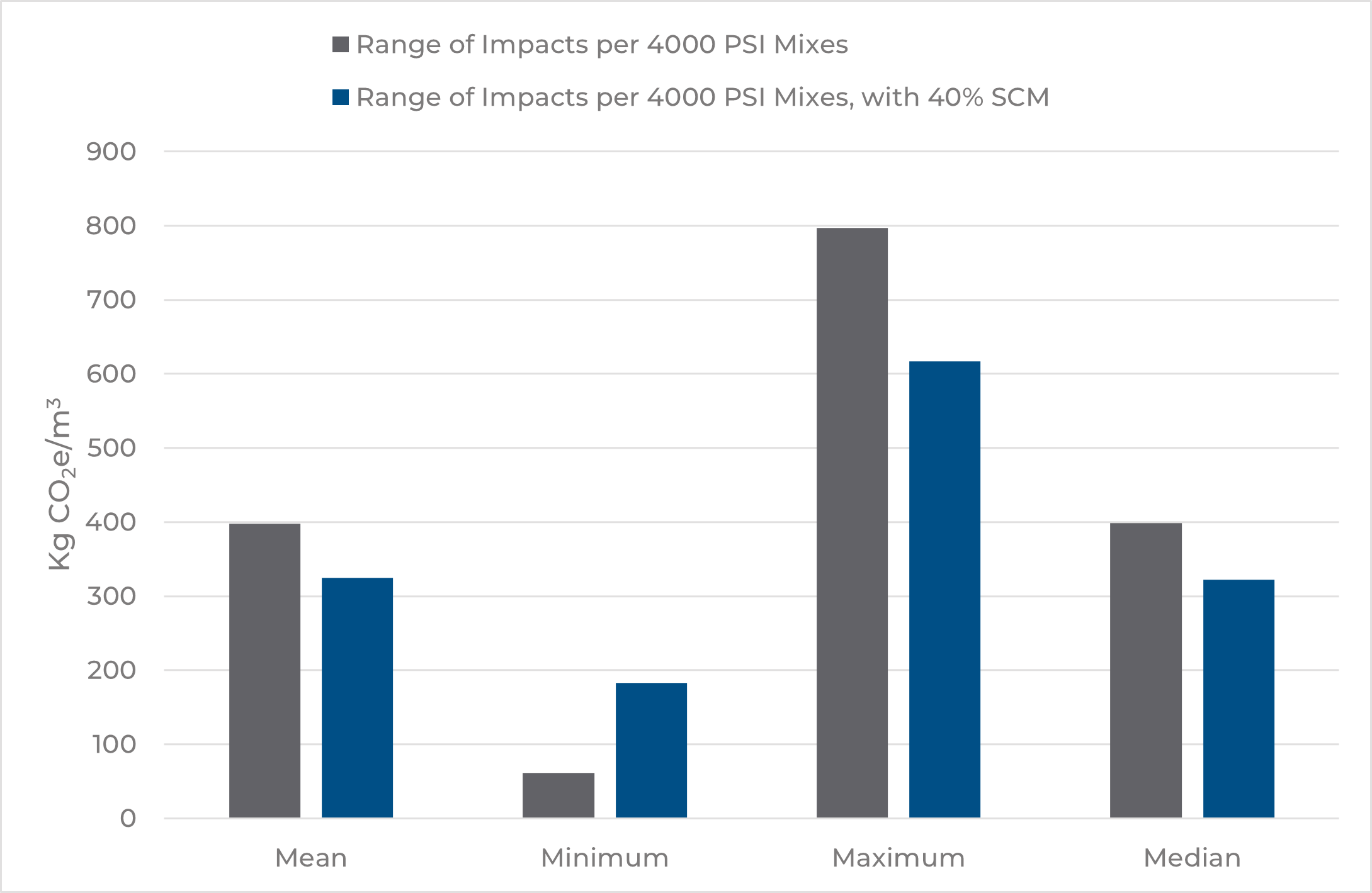
Note. Adapted from Climate Earth Inc. (n.d.). Green Concrete Selector. Climate Earth. https://selector.climateearth.com/Home/Results?PSI=4000&SCM=40
Hossain et al. (2018) in their journal article “Evaluation of environmental impact distribution methods for supplementary cementitious materials” determined that concrete made with SCMs using the mix designs listed in Table 2 resulted in a reduction of 20% (MD-2), 38% (MD-3), and 24% (MD-4) of greenhouse gas (GHG) emissions compared to using only ordinary Portland cement in the concrete mix (MD-1).
The study also demonstrated a reduction in energy consumption when using SCMs in the concrete mix designs, 15% (MD-2), 29% (MD-3), and 20% (MD-4), respectively. The findings from Hossain et al. (2018) determined that the use of SCMs in the concrete mix reduced the carbon emissions released to the environment.
Fly ash, GGBFS, and silica fume have shifted from industrial waste to a by-product status, improving concrete quality and having advantages from an environmental perspective (Rodríguez-Robles et al., 2019). The primary treatment of 1 kg of the SCMs stated before means fewer emissions to the air (SOx,NOx, and dust) against 1 kg of ordinary Portland cement, establishing that the partial replacement of cement is highly beneficial for the environment (Rodríguez-Robles et al., 2019).
Samad et al. (2017) presented in their article “Strength development characteristics of concrete produced with blended cement using ground granulated blast furnace slag (GGBS) under various curing conditions” a study by the UK Concrete Industry Alliance tabulated by Higgins (2006) that exemplified the environmental benefits of using GGBFS and fly ash as a replacement of cement in concrete, shown in Table 1.
Table 1. Calculated Environmental Impacts for 1 ton of Concrete
Note. The environmental impacts are per ton production of a C30 concrete. Adapted from Higgins, D. (2006). Sustainable concrete: How can additions contribute. Proceedings of the Institute of Concrete Technology Annual Technical Symposium. Published. Institute of Concrete Technology Camberley, UK.

Table 1 shows a reduction of 40% CO2 emissions when replacing 50% of Portland cement with GGBFS and an insignificant impact in mineral extraction (8%). Also, there is a 17% CO2 emissions reduction when replacing 30% of Portland cement with fly ash. Additionally, Higgins (2006) concluded that in 2005 the UK saved 2.5 million tons of CO2 emissions, 2 million MW hours of energy, 4 million tons of mineral extraction, and potentially 2.5 million tons of material sent to landfills thanks to the use of fly ash and GGBFS in concrete.
Nevertheless, Miller (2018) in her journal article “Supplementary cementitious materials to mitigate greenhouse gas emissions from concrete: can there be too much of a good thing?” concluded that, depending on the SCM type and the changes in transportation, “high levels of SCM replacement do not consistently result in lower GHG emissions for concrete production per unit strength”. For instance, Miller determined that transportation (distance and mode) can counterbalance the advantages of using SCMs for reducing GHG emissions. For this reason, every project should be considered based on global parameters, including logistics.
4. Qualitative Benefits in Concrete
Sanytsky et al. (2020) in their article “Eco-efficient blended cements with high volume supplementary cementitious materials” analyzed the implementation of blended cements as an optimal solution to low carbon emissions in the cement industry and evaluated the impact that SCMs, like GGBFS and superfine zeolites (SFZ), and limestone additives had on their physical and mechanical properties, evaluating compressive strength as shown in Figure 4.
Figure 4. Test Results of Blended Cements’ Compressive Strength
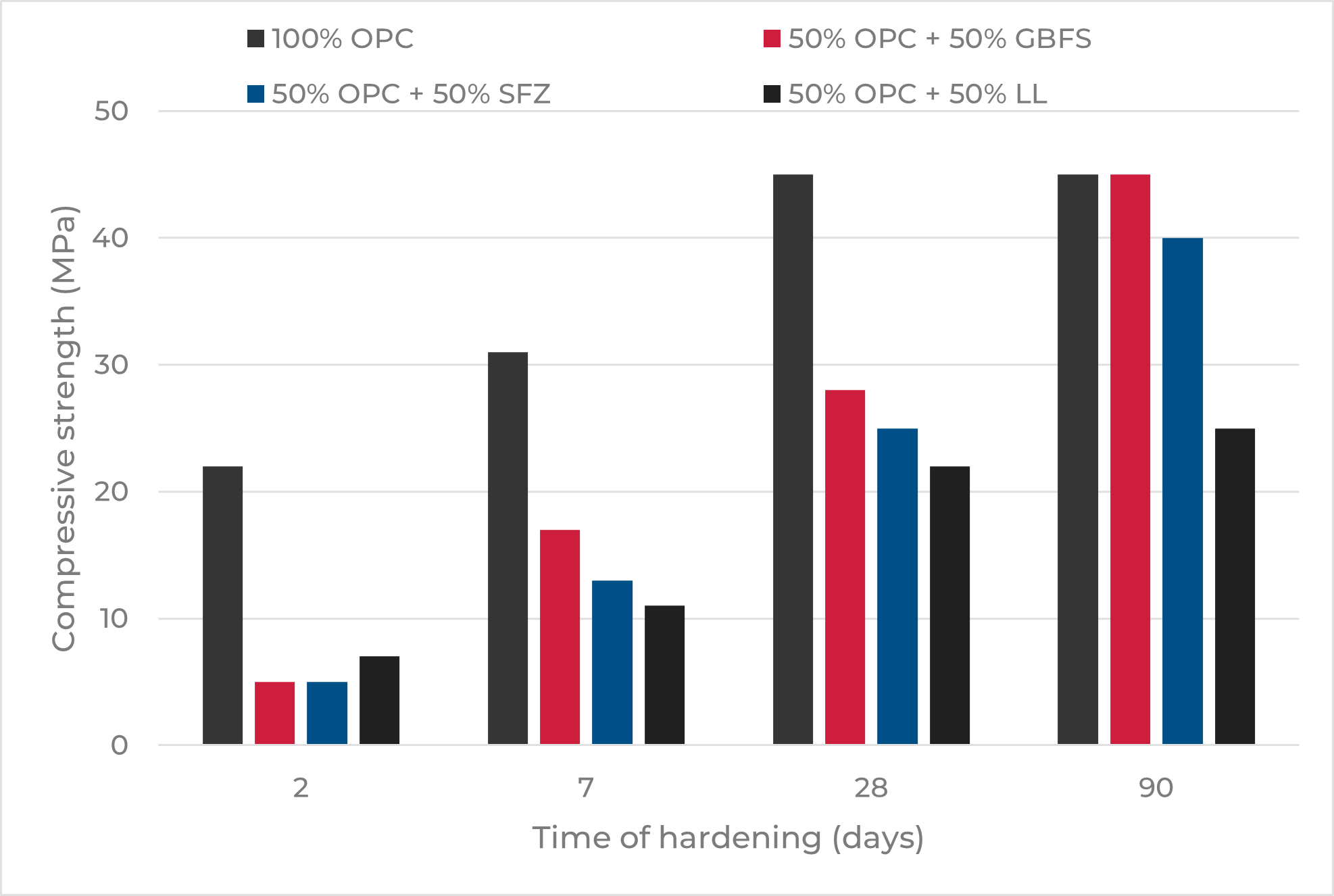
Note. Adapted from Sanytsky, M., Kropyvnytska, T., Ivashchyshyn, H., & Rykhlitska, О. (2020). Eco-efficient blended cements with high volume supplementary cementitious materials. Budownictwo i Architektura, 18(4), 5–14. https://doi.org/10.35784/bud-arch.816
The test results of compressive strength (see Figure 4) done by Sanytsky et al. (2020) demonstrates that even though a high volume of SCMs in the blended cement mix decreases its compressive strength at an early stage, this will end up increasing over time, resulting in values close to a 100% of ordinary Portland cement’s compressive strength by 90 days.
Furthermore, Hossain et al. (2018) determined in the results of their study based on different concrete mix designs, shown in Table 2, a lower acidification impact from the mixes MD-2, MD-3, and MD-4 compared to MD-1 (OPC cement), 14%, 30%, and 18% respectively.
The use of metakaolin (MK) as supplementary cementitious material is also beneficial for concrete quality; Ahmed et al. (2019) stated that using MK as a partial replacement of cement will increase by 20% the compressive strength of concrete. The finest compressive strength is reached by 10% substitution, as shown in Table 3, improving the mechanical properties of concrete along with its quality and resistance.
Table 2. Mix-Design (MD) of Different Concrete Used in the Study
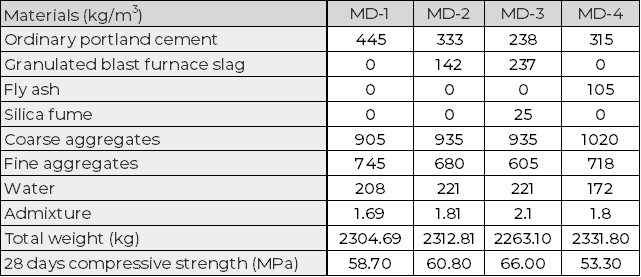
Note. Adapted fromHossain, M., Poon, C., Dong, Y., & Xuan, D. (2018). Evaluation of environmental impact distribution methods for supplementary cementitious materials. Renewable and Sustainable Energy Reviews, 82, 597–608. https://doi.org/10.1016/j.rser.2017.09.048
Table 3. Workability, Sitting Times of Metakaolin Concretes
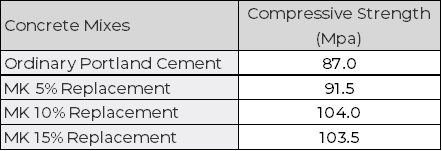
Note. Adapted from Ahmed, R., Jaafar, M. S., Bareq, M., Hejazi, F., & Rashid, R. S. (2019). Effect of supplementary cementitious material on chemical resistance of concrete. IOP Conference Series. Earth and Environmental Science, 357(1), 12016–. https://doi.org/10.1088/1755-1315/357/1/012016
Diedrick (2019) in his article “Building Greener, Building Better with Supplementary Cementitious Materials” indicated that even though the concrete has many advantages, like workability and finishability in its plastic state, the SCMs improve its hardened properties.
Slag cement and fly ash in the early stages will lower concrete strength, but after the 28-day and beyond will substantially increase its long-term strength. Furthermore, SCMs will reduce permeability to chloride at later stages, improving the durability of concrete structures (Diedrick, 2019).
Diedrick (2019) also indicated that SCMs help concrete resists an alkali-silica reaction (ASR), sulfate attack, and thermal stress. ASR is responsible for expanding and cracking concrete, and SCMs can prevent this; usually, blends of silica fume and slag cement or silica fume and fly ash prevent ASR expansion. Sulfates also can cause an expansion in ordinary Portland cement when reacting with alumina. However, SCMs prevent these sulfate attacks due to small compounds that react with these while keeping out sulfate-bearing waters. The application of slag cement and fly ash in balanced mixes can also prevent cracking and deterioration of structural integrity due to thermal stress by reducing high temperatures and heat generation rates.
5. Conclusions
The cement industry has a significant impact on the environment. In the search to reduce this impact, SCMs can play a major role in reducing the environmental impacts generated by the production of concrete. More than 20% of potential greenhouse gases can be reduced by using SCMs instead of ordinary Portland cement.
In addition to reducing greenhouse emissions, SCMs provide qualitative benefits to concrete. As a result, SCMs provide strength improvement to concrete, increase concrete life, and resist alkali-silica reaction, sulfate attacks, and thermal stress.
References
- Ahmed, R., Jaafar, M. S., Bareq, M., Hejazi, F., & Rashid, R. S. (2019). Effect of supplementary cementitious material on chemical resistance of concrete. IOP Conference Series. Earth and Environmental Science, 357(1), 12016–. https://doi.org/10.1088/1755-1315/357/1/012016
- Climate Earth Inc. (n.d.). Green Concrete Selector. Climate Earth. https://selector.climateearth.com/Home/Results?PSI=4000&SCM=40
- Coppola, L., Coffetti, D., & Crotti, E. (2018). Plain and Ultrafine Fly Ashes Mortars for Environmentally Friendly Construction Materials. Sustainability, 10(3), 874. https://doi.org/10.3390/su10030874
- Diedrick, D. (2019, November 04). Building Greener, Building Better with Supplementary Cementitious Materials. Materials That Perform: Building Materials Suppliers. https://www.materialsthatperform.com/green-building-materials-and-solutions
- Hanson, K. (2017, September 22). SCMs in Concrete: Natural Pozzolans. National Precast Concrete Association. https://precast.org/2017/09/scms-concrete-natural-pozzolans/
- Higgins, D. (2006). Sustainable concrete: How can additions contribute. Proceedings of the Institute of Concrete Technology Annual Technical Symposium. Published. Institute of Concrete Technology Camberley, UK.
- Hossain, M., Poon, C., Dong, Y., & Xuan, D. (2018). Evaluation of environmental impact distribution methods for supplementary cementitious materials. Renewable and Sustainable Energy Reviews, 82, 597–608. https://doi.org/10.1016/j.rser.2017.09.048
- Kosmatka, S. H., & Wilson, M. L. (2016). Design and Control of Concrete Mixtures (16th ed.). Portland Cement Association.
- Miller, S. A. (2018). Supplementary cementitious materials to mitigate greenhouse gas emissions from concrete: can there be too much of a good thing? Journal of Cleaner Production, 178, 587–598. https://doi.org/10.1016/j.jclepro.2018.01.008
- Natural Pozzolan Association. (2021). National Pozzolan Association: How Natural Pozzolans Improve Concrete. Pozzolan. https://pozzolan.org/improve-concrete.html
- Nicoara, A. I., Stoica, A. E., Vrabec, M., Šmuc Rogan, N., Sturm, S., Ow-Yang, C., Gulgun, M. A., Bundur, Z. B., Ciuca, I., & Vasile, B. S. (2020). End-of-Life Materials Used as Supplementary Cementitious Materials in the Concrete Industry. Materials, 13(8), 1954–. https://doi.org/10.3390/ma13081954
- Preston, F., & Lehne, J. (2018). Making Concrete Change: Innovation in Low-carbon Cement and Concrete. Chatham House.
- Rodgers, L. (2018, December 17). Climate change: The massive CO2 emitter you may not know about. BBC News. https://www.bbc.com/news/science-environment-46455844
- Rodríguez-Robles, D., van den Heede, P., & de Belie, N. (2019). Life cycle assessment applied to recycled aggregate concrete. New Trends in Eco-Efficient and Recycled Concrete, 207–256. https://doi.org/10.1016/b978-0-08-102480-5.00009-9
- Samad, S., Shah, A., & Limbachiya, M. C. (2017). Strength development characteristics of concrete produced with blended cement using ground granulated blast furnace slag (GGBS) under various curing conditions. Sadhana (Bangalore), 42(7), 1203–1213. https://doi.org/10.1007/s12046-017-0667-z
- Sanytsky, M., Kropyvnytska, T., Ivashchyshyn, H., & Rykhlitska, О. (2020). Eco-efficient blended cements with high volume supplementary cementitious materials. Budownictwo i Architektura, 18(4), 5–14. https://doi.org/10.35784/bud-arch.816
- Statista. (2021, January 14). Global cement manufacturing CO2 emissions 1990–2019, by country. https://www.statista.com/statistics/1091672/carbon-dioxide-emissions-global-cement-manufacturing/
- Sun, J., Shen, X., Tan, G., & Tanner, J. E. (2019). Compressive strength and hydration characteristics of high-volume fly ash concrete prepared from fly ash. Journal of Thermal Analysis and Calorimetry, 136(2), 565–580. https://doi.org/10.1007/s10973-018-7578-z
- United States Environmental Protection Agency. (2020, July 24). Cement Manufacturing Enforcement Initiative. US EPA. https://www.epa.gov/enforcement/cement-manufacturing-enforcement-initiative
About the Author(s)
Bruno G. Diaz, MBA
Mr. Diaz is an Industrial Engineer. Prior to joining PEC Consulting, he worked in mine operations analyzing data to recommend improvements to operating efficiencies and related cost reductions. With PEC Consulting, he has been involved in the preparation of feasibility studies for the cement industry. He holds a BS in Industrial Engineering from the University of Santo Toribio de Mogrovejo, Peru, and an MBA from Lindenwood University, Missouri.
Francisco M. Benavides, P.E.
Mr. Benavides, Principal Consultant at PEC Consulting Group LLC, has many years of experience in project management, design and construction. He has conducted bankable feasibility studies, economic analysis of mineral transport alternatives, plant valuations for acquisitions and for financing purposes, and due diligence studies. He holds an MBA from Kellogg School of Management, Northwestern University, Evanston, Illinois; a Bachelor of Science and Professional Degree in Civil Engineering from the Missouri University of Science & Technology, Rolla, Missouri; and has completed Graduate Studies in Engineering Management and Environmental Engineering at Missouri University of Science & Technology.
PEC Consulting Group LLC | PENTA Engineering Corporation | St. Louis, Missouri, USA
How can we help you? Get in touch with our team of experts.
